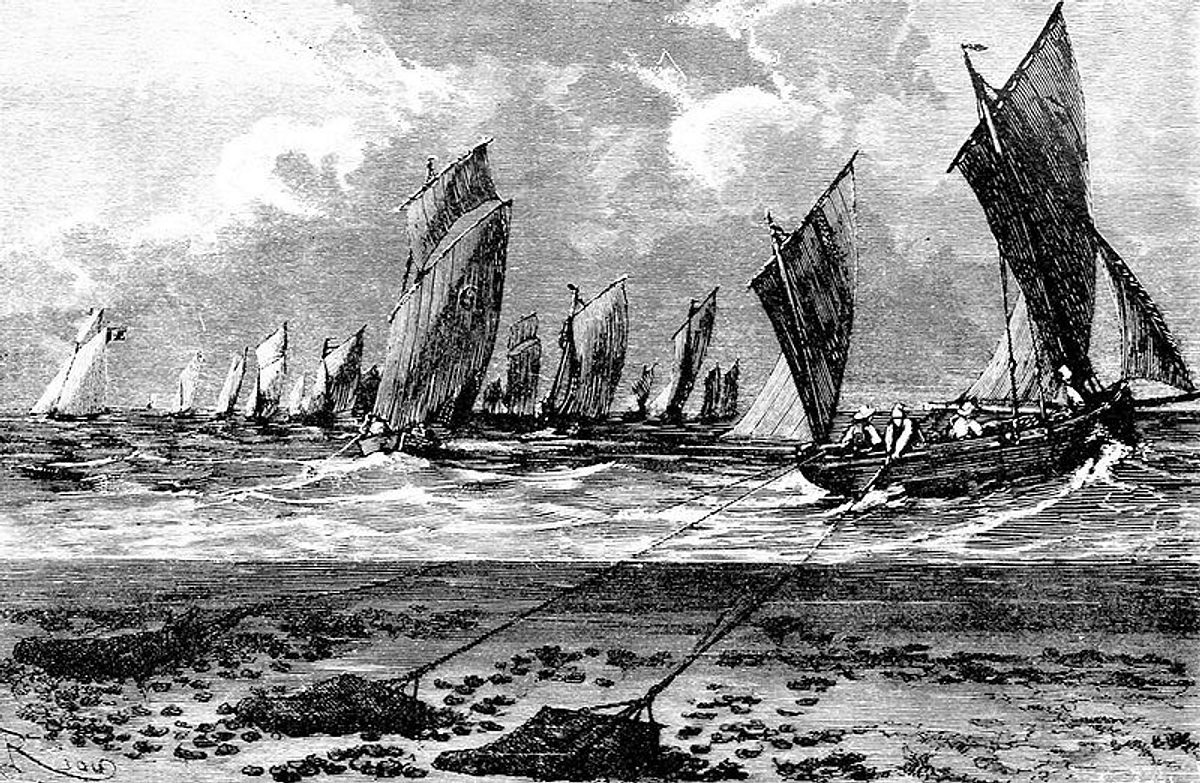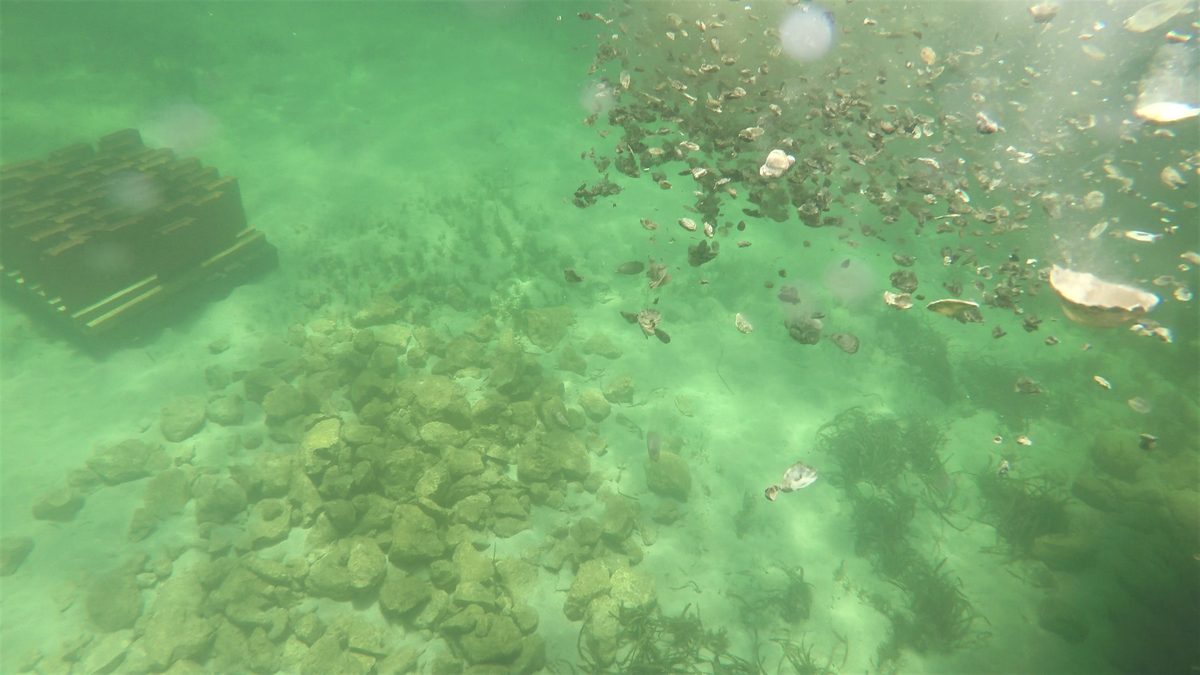
Kangaroo Island Oyster Reef Restoration Project
On this page:
- About the project
- The history of native flat oyster reef decline
- Why are oyster reefs so important?
- What are we doing to restore shellfish reefs?
- Collecting native oyster spat to seed these reefs
- Community input
- Where are these new reefs?
- Monitoring fish and shellfish life on the new reefs
- Thank you to our supporters
Image above from Stefan Andrews Ocean Imaging.
About the project
The Kangaroo Island Landscape Board has constructed 20 small, native flat oyster (Ostrea angasi) shellfish reefs close to Kingscote and American River to restore the health and function of these important shellfish and fish habitats. The new reefs provide habitat for premium recreational fishing species and contribute to a national initiative to restore shellfish reefs.
These low-profile artificial reefs have been constructed using limestone, recycled shell, terracotta tile and ceramic razorfish forms to support natural recruitment of native flat oysters. The reefs will be seeded with local native flat oyster spat that have been wild-caught from within the bay. Over time, the reefs are expected to grow and support the natural settlement of native flat oysters, and connect to form a continuous reef habitat.
This project is supported by the Kangaroo Island Landscape Board, through funding from the Australian Government’s National Landcare Program: Fisheries Habitat Restoration Program.
Razorfish to the rescue: A ceramic solution to restore Kangaroo Island's native oyster populations
The history of native flat oyster reef decline
Native flat oyster reefs were once widespread across southern Australia, including throughout Nepean Bay on Kangaroo Island, but were fished to near-extinction over a century ago. The remaining oyster shell was then dredged and used in construction, leaving no substrate on the seabed for new oyster larvae to settle on and grow. This project aims to restore this lost substrate so native oysters can settle and reinstate the lost benefits of this ecological community.

Why are oyster reefs so important?
Native oyster reefs were once widespread across the estuaries and coastal waters of southern Australia, and filled a number of crucial roles. The benefits of these reefs include:
- providing crucial habitats for a broad range of temperate coastal marine species, such as King George whiting, southern calamari, seadragons and pipefish, and in doing so enhancing recreational and commercial fish and shellfish stocks
- filtering water and improving water clarity and quality
- stabilising sediment and protecting shorelines from storm surge wave-energy.

What are we doing to restore shellfish reefs?
Construction of 20 small, low-profile reefs has been completed over the 2022-2023 summer in waters adjacent to Kingscote and American River. Each reef is approximately 100 m² in size and 3–4 m deep. The reefs have been placed in bare sand close to seagrass and rocky reefs to connect these productive coastal habitats for fish and invertebrates.
The reefs are made of limestone, oyster shells, terracotta tile modules and ceramic forms, providing a substrate for marine organisms to settle on and grow. These materials have been sourced locally, or are recycled, and include discarded oyster shells from The Oyster Farm Shop in American River.
200 tonnes of limestone rock was deployed to form the base for the reefs, with other materials placed amongst the rock piles. Ceramic and terracotta tile ‘razorfish forms’ have been recreated by ceramicist Jane Bamford and the Kingscote Men’s Shed respectively to mimic the real razorfish that are found in Nepean Bay. Razorfish shells provide a natural surface for native flat oyster larvae to settle on. By placing these razorfish forms together in high densities and sheltering them between limestone patches, we aim to protect naturally settled baby oysters (spat) from predation while they are young.

Collecting native oyster spat to seed these reefs
There is a reliable source of native flat oyster spat in the sheltered waters of Nepean Bay, but the substrate for it to attach to and grow on is missing. We designed spat collecting modules with baskets of discarded oyster shell to provide the young oysters with a preferred and protected place to settle. We installed these modules at multiple locations between Kingscote and Brown Beach, at the start of the seasonal spawning of native flat oysters. At the end of the growing season samples of shell with attached spat were collected and the settled oysters counted. Results showed settlement and high survival of native flat oysters across every collector site between Eastern and Western Cove, with slightly larger spat at American River in Eastern Cove. The shell from the collectors with attached native oyster spat was spread over the new reef structures to give natural recruitment a boost.

Community input
The KI Landscape Board began consulting with the local community about these reefs in 2018, when the idea for the project was first conceived. Community meetings, presentations and consultation with technical and scientific working groups and local industry were used to gather valuable knowledge of the historical and current state of native flat oysters around Kangaroo Island. This information helped select suitable reef locations and determine where to collect oyster spat. Local industry organisation KI Shellfish based in American River have been closely involved throughout the project, collecting spent oyster shell for the project, and deploying the terracotta tile modules to the reef.

Where are these new reefs?
The reefs have been built near the townships of Kingscote and American River. The sites were selected after consultation with the community, marine infrastructure agencies and local industry including fishery and aquaculture stakeholders.
The benefits of these reefs can be seen already, providing structure, which in turn attracts fish species targeted by recreational fishers. The encrusted surfaces will provide habitat for young fish and invertebrates. The flat oysters will take a few years to grow and produce their own larvae, and eventually become a restored reef reflective of those lost.



Monitoring fish and shellfish life on the new reefs
Before the reefs were built, each site was surveyed for fish species assemblages and abundance to create a baseline dataset using Baited Remote Underwater Video stations (BRUVs). After the reefs were constructed, the KI Landscape Board surveyed the sites again and found abundance and diversity of fish increased significantly, and that the reefs are attracting recreational fishing species, particularly King George whiting.
We are also monitoring the growth of native flat oysters overtime, surveying the densities, size and survival of shellfish attached to the reef structures each year. Diver surveys of the limestone boulders have identified good natural recruitment of native flat oysters at both reefs. So far, settlement of spat has been highest at Kingscote and the largest oysters found on the American River reef. Native flat oysters have settled on all reef substrates including limestone, ceramic razorfish forms and in particularly high densities on terracotta roof tiles.

The KI Landscape Board will continue to monitor the reefs to determine which materials and structures have provided the best habitat for native flat oysters and fish life. This information will be shared to guide future shellfish reef restoration projects here on Kangaroo Island and across Australia.

Thank you to our supporters
This project is supported by the Kangaroo Island Landscape Board, through funding from the Australian Government’s National Landcare Program: Fisheries Habitat Restoration Program.
